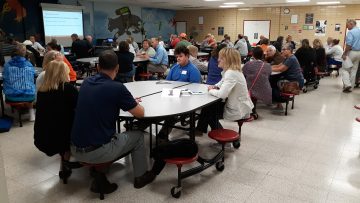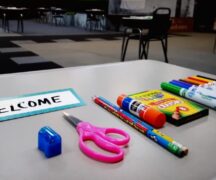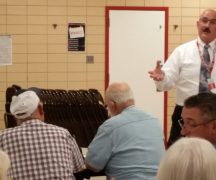By JAN LARSON McLAUGHLIN
BG Independent News
As the new Bowling Green City Schools facilities task force leaders toured the school buildings recently, they came upon a sign that seemed to fit the district’s situation.
“I’m not telling you it’s going to be easy. I’m telling you it’s going to be worth it.”
Nearly 60 community members met in the high school cafeteria last week for the first facilities task force meeting. They first addressed brick and mortar issues, and got an update on the condition of the school buildings. Then they touched on the “elephants in the room” that are affecting the future of the buildings.
Two task forces are working on the school building issue – one looking at the facilities and the other at the finances. While both groups are working independently of each other, the financial task force will make its final decisions based on the goals set by the facilities task force.
Once both task forces are done, recommendations will be made to the board of education of how the district should proceed. Those recommendations could range from doing nothing to the buildings, to renovating the existing buildings, to building new elementaries at their current sites, to consolidating the elementaries into one new building.
The school administration and board are taking a hands-off approach to the task force process. They provide information when requested, but don’t attend meetings and don’t offer input.
David Conley, who is facilitating the financial task force, provides live video via Facebook for those who can’t attend the meetings.
The facilities task force did not videotape last week’s meeting. A member of the task force, Grant Chamberlain suggested that the meetings be kept “confidential” since items discussed at the meetings could be harmful to business owners.
The facilities task force coordinators said they had originally planned to give school district officials updates on what was being discussed – not to get approval or input, but just to keep them up-to-date. Some members of the task force objected, and a decision will be made at the next meeting on Oct. 24, at 7 p.m., in the high school cafeteria.
Leading the facilities task force are three members of Fanning Howey, a firm of architects, engineers, planners and former school administrators who specialize in school buildings. The firm has assisted more than 100 Ohio school districts, including Eastwood, North Baltimore and Northwood in Wood County.
Three members of the firm are volunteering their time to work with the Bowling Green facilities task force – architects Steve Wilczynski and Dan Obrynba, plus former school superintendent Tim Hamilton.

Task force meeting in high school cafeteria
Prior to last week’s meeting, the team toured the district’s school buildings and reviewed the most recent report from the Ohio Facilities Construction Commission, which is the agency that establishes state funding rules.
The team reported that Bowling Green’s ranking by the OFCC is not good – meaning no money is available now, and if it becomes available some day, it will pay for an estimated 17 percent of the project, if the buildings are designed to state specifics.
“Your ranking is heading in the wrong direction,” Hamilton said, estimating there are 100 school districts in front of Bowling Green for funding. “There are a lot of districts ahead of you.”
The task force coordinators reviewed their findings from school tours and and 2015 OFCC assessments which covered items like heating, roofing, ventilation, electrical, plumbing, windows, foundation, lighting, security and technology.
All of the elementaries are too small – even before factoring in student growth. All have small libraries, and Conneaut and Kenwood have possible air quality problems.
Crim is in the best shape, having a major addition and renovation in 2012. The OFCC assessment determines the cost of renovations compared to replacement for all buildings. Renovations at Crim were estimated at $2.3 million, compared to $12 million to replace.
Crim is equipped with a sprinkler system and air conditioning – unlike the other elementaries. But there is no logical area for new construction due to the location of storm drainage.
Conneaut Elementary was built in 1954, with additions in 1987 and 1988. This school has the highest renovation to replacement ratio, with renovation estimated at $8 million and new construction at $10.3 million.
“When you hit two-thirds, you think about replacing a building,” Obrynba said.
Conneaut needs better front door security, lacks storage areas, has problematic steam heat, uses modular classrooms, and has asbestos in the ceilings that would need to be dealt with if disturbed for renovations.
Kenwood was built in 1953, with an addition put on in 1988. The renovation costs were put at $6.7 million, compared to replacement costs of $11 million.
Like the other elementaries, Kenwood has limited parking, original ventilation, air and mold concerns, limited storage, and asbestos that would need to be removed if disturbed.
The middle school, which was built in 2008 and added onto earlier this year, has about $2.3 million in recommended renovations – primarily for technology.
The high school was built in 1963, with additions in 1989. According to the OFCC assessment, the building needs $23 million in renovations, while the cost to replace was set at $44 million. The classroom sizes vary greatly, there is limited storage, ponding of water on the roof, and temperature control issues.
Unlike the elementaries, the high school has ample parking.
Members of the task force were asked to discuss in small groups their top priorities for school buildings. They listed items like more space, updated HVAC, increased security, better mechanical systems and updated technology.
They were also asked to list the “elephants in the room” that may be standing in the way. Those issues included:
- Taxes for young families.
- A desire to keep neighborhood schools.
- Poor voter turnout.
- Lack of community consensus.
- Lack of knowledge about the needs of students and mechanical building needs.
- Lack of consensus on what the community owes students.
- Lack of consensus on neighborhood versus consolidated schools.
- Parking and traffic flow.
- Uncertainty about renovating or building new schools.
- Poor maintenance of buildings.
- State test scores.
- Affordability.
- Lack of equitable resources.
A member of the task force mentioned that construction costs increase about 6 to 7 percent each year. The latest tariffs and labor shortage are making the annual increase even higher, another member said.
The goal of the facilities task force is to set a vision, provide defensible data, and build a consensus.
The facilities task force will have to determine if its building proposal is affordable for district residents. And it will have to decide if the district should work with the Ohio Facilities Construction Commission.
The financial task force will have to wait for the facilities task force to make some decisions before it can proceed with more detailed plans. However, the financial task force has started with preliminary research by identifying building funding options, such as income tax, property tax, new business development taxes, or a combination of those.





